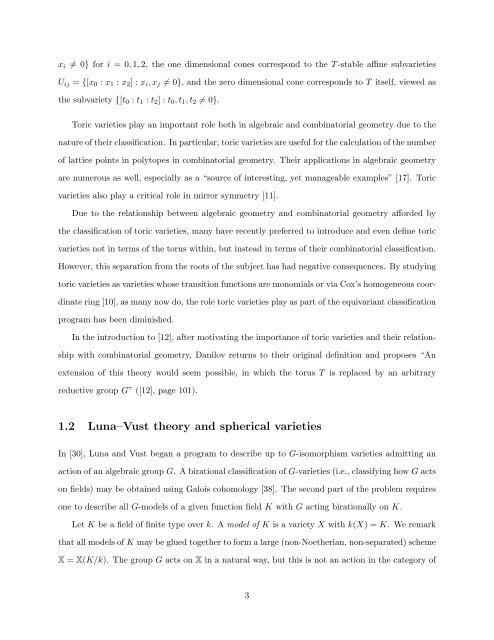Equivariant Embeddings of Algebraic Groups
Equivariant Embeddings of Algebraic Groups
Equivariant Embeddings of Algebraic Groups
Create successful ePaper yourself
Turn your PDF publications into a flip-book with our unique Google optimized e-Paper software.
x i ≠ 0} for i = 0, 1, 2, the one dimensional cones correspond to the T -stable affine subvarieties<br />
U ij = {[x 0 : x 1 : x 2 ] : x i , x j ≠ 0}, and the zero dimensional cone corresponds to T itself, viewed as<br />
the subvariety {[t 0 : t 1 : t 2 ] : t 0 , t 1 , t 2 ≠ 0}.<br />
Toric varieties play an important role both in algebraic and combinatorial geometry due to the<br />
nature <strong>of</strong> their classification. In particular, toric varieties are useful for the calculation <strong>of</strong> the number<br />
<strong>of</strong> lattice points in polytopes in combinatorial geometry. Their applications in algebraic geometry<br />
are numerous as well, especially as a “source <strong>of</strong> interesting, yet manageable examples” [17]. Toric<br />
varieties also play a critical role in mirror symmetry [11].<br />
Due to the relationship between algebraic geometry and combinatorial geometry afforded by<br />
the classification <strong>of</strong> toric varieties, many have recently preferred to introduce and even define toric<br />
varieties not in terms <strong>of</strong> the torus within, but instead in terms <strong>of</strong> their combinatorial classification.<br />
However, this separation from the roots <strong>of</strong> the subject has had negative consequences. By studying<br />
toric varieties as varieties whose transition functions are monomials or via Cox’s homogeneous coordinate<br />
ring [10], as many now do, the role toric varieties play as part <strong>of</strong> the equivariant classification<br />
program has been diminished.<br />
In the introduction to [12], after motivating the importance <strong>of</strong> toric varieties and their relationship<br />
with combinatorial geometry, Danilov returns to their original definition and proposes “An<br />
extension <strong>of</strong> this theory would seem possible, in which the torus T is replaced by an arbitrary<br />
reductive group G” ([12], page 101).<br />
1.2 Luna–Vust theory and spherical varieties<br />
In [30], Luna and Vust began a program to describe up to G-isomorphism varieties admitting an<br />
action <strong>of</strong> an algebraic group G. A birational classification <strong>of</strong> G-varieties (i.e., classifying how G acts<br />
on fields) may be obtained using Galois cohomology [38]. The second part <strong>of</strong> the problem requires<br />
one to describe all G-models <strong>of</strong> a given function field K with G acting birationally on K.<br />
Let K be a field <strong>of</strong> finite type over k. A model <strong>of</strong> K is a variety X with k(X) = K. We remark<br />
that all models <strong>of</strong> K may be glued together to form a large (non-Noetherian, non-separated) scheme<br />
X = X(K/k). The group G acts on X in a natural way, but this is not an action in the category <strong>of</strong><br />
3
















